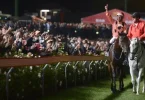Probably no person on this planet hasn’t heard about Las Vegas. Hollywood has made this city famous all around the world, and it’s one of the most popular among all kinds of tourists.
Despite a decline in casino revenue in Las Vegas, which dropped to 40% in 2025, totaling $820 million, gambling remains one of the most profitable business sectors. The luxury and atmosphere, where you know for sure that what happens in Vegas stays in Vegas, is the main driver behind this gambling hub’s popularity.
If you want a nice venue, have fun, and make unforgettable memories, it’s worth checking out some other US land-based casinos for sure. But if you want to transport your worries instantly, check the USA casinos for UK players and other English-speaking individuals.
Online casinos always try to grasp Vegas’s mood and imitate the luxury behind it. But what if we dive into the story about how the casinos started being associated with a lavish, art, and luxury, and who stands behind these ideas?
Contents
The initial approach to interior design matters
One of the pioneers of the idea of design that best reflects the spirit of a casino was Bill Friedman, a former gambling addict. In the late 1960s, he was struggling with his obsession with craps, baccarat, and blackjack. As he recalls, “I had reached a point in life where I was left with two options: either keep playing or keep living. There was nothing else left in between.”
Friedman chose a life and became a professor at the University of Nevada, teaching the first course in casino management. Later, he took a job at Castaways Hotel and the Silver Slipper as a casino executive. Neither hotel was doing well, had low occupancy rates, and had casino halls with no attendees when he took over.
Even though every casino on the Strip offered the same variety of games and the same odds, the hotels where Friedman worked as an executive fell far behind the others in terms of revenue. In his attempt to understand why no one was coming to his hotels, he started visiting the most crowded casinos in the city. He made a list of the features the most successful areas had in common.
He conducted research, attending more than 80 of the most successful gaming halls across Las Vegas, summarizing his conclusions in a book, “Designing Casinos to Dominate the Competition.” He distilled his research into 13 main rules that would mostly stand on how to funnel the visitors from the entry of the hotel and make them lose themselves in a game without paying attention to the amounts of money and time they spend at the casino.
Some of his main thoughts are turning slot machines into a maze-like arrangement, with low ceilings and no natural light or clocks in the areas, so players wouldn’t notice how long they play, and the decor is related to gambling features only.
Friedman has written this book from the point of view of his own experience in gambling. He used to tell, “My rules work, I know what gamblers want, I used to gamble”. And it worked, for years, players seemed to be happy to play at halls with no decor, overcrowded with slot machines, and disoriented layouts.
But in the late 1970s, things started to change, and the number of visitors started to decline slightly. Thomas Roger, who worked as a designer at that time, felt that the drop in occupancy and income was partly due to the unattractive and uncomfortable interiors of Las Vegas hotels.
Recreating the idea of luxury in casino design
In 1980, Thomas attended a charity event. He met Steve Wynn, who was the owner at the time of the Golden Nugget hotel, which he had turned into an upscale resort with lavish suites and spacious halls. He offered Thomas a position on his team. Thomas said “Yes”. As he recalled later, “What drew me to Steve was that he also wanted to change Vegas,” he recalls. “He also didn’t want to build more of the same tasteless crap.”
Both of them knew that they would change the rules completely, changing the look of Las Vegas hotels for good. They reinvented the architecture of the casino as a concept, creating spaces where people could enjoy the fact of losing money, surrounded by high-class design and art pieces. “I don’t do focus groups, I create rooms that I want to stay in,” said Thomas in one of his interviews.
After the official collaboration had been set into place, Steve Wynn’s Vegas hotels took off rapidly, and some of them became legends of Las Vegas. As Wynn claimed, “Roger’s taste level and his creativity are sixty percent of the success we’ve had.” Some of the most successful projects were Mirage, inspired by tropics, Treasure Island, and pirate battle, Bellagio with South of France and North of Italy impacts.
Mirage
It was one of the latest hotels in Las Vegas that remained almost intact from Friedman’s model, and he was even one of the consultants on the designs of the gambling areas. Expansive resort with more than 3.000 rooms and a tropical theme. Guests were lured by the huge replica of an erupting volcano in front of the main entrance, and continued with the walkway directly to the cashier in the center of the dark casino hall.
Bellagio
The next big project of Wynn and Thomas was the Bellagio Hotel, which broke the traditional Las Vegas patterns, with a total investment cost to Wynn $1.6 billion, where spending on a world-class art collection had reached $350 million. Something that anyone would even think of doing in Las Vegas. Both of them believed that people tend to spend more when they are surrounded by art, beauty, and luxury. “They feel glamorous in glamorous spaces, and rich in rich spaces. And who doesn’t want to be rich?” The efforts paid off. Bellagio generated the highest amount of profit that any other casino has in the history of Las Vegas, proving the point of its creators. Guests have changed the way they spend their money.
Comfort and Quality
The thing that makes his approach genuinely unique is how Roger is capable of predicting each detail and considering the long-term perspectives of his work, making his interiors not only masterpieces in the art of design but also durable in time as well.
He deliberates on the levels of comfort of his furniture, taking inspiration from the French Baroque, an era of the golden age of decor, when the first chairs with lumbar support were presented to Louis XIV. Roger reflects on how to sit for hours at the table, playing poker, if your back is hurt. So he decides to install comfort chairs in the gambling areas. “If a chair isn’t working, if it isn’t quite as comfortable as it should be, then I’ll know about it, because people won’t sit there,” he says. “They’ll go somewhere else. The performance of the space will suffer, and the Operations guys will complain.”
Every piece of interior Thomas designs is processed to the smallest detail. If it is carpet, he thinks about stains; if it is a coffee table, it needs to be protected by roller bags and drinks. He doesn’t think only about the aesthetic part of his stuff, but also about how it will be able to pass the test over time. Drunken visitors and possible damage are something that needs to be taken into account.
What is luxury according to Roger Thomas?
This man’s role in reshaping the gambling industry is undeniable; he proved his point. Beauty is a kind of essence that makes you forget about time and loss. People who attend the hotels that he had worked on feel stunned by the floating statues, parasols on the ceiling, female-shaped chandeliers above the tables, and they just want to enjoy the beauty. Seduced by the art performed in the interior, even if gambling wasn’t their first thought, it is hard to resist thinking of giving it a try at a table and seeing what happens next. Creating emotions is what makes this man a genius in his work. What is Luxury by Roger Thomas?
“Luxury for me is a combination of original and unique expression, something is only luxurious if you haven’t seen it before, if it’s not a copy. Something of quality, it’s not only the quality of components and materials, but the quality in the essence of the Thought… and it is something that creates an Emotional Experience. When we are going to design something exceptional, we don’t say let’s make a beautiful room, we say let’s create an extraordinary emotional experience”.







